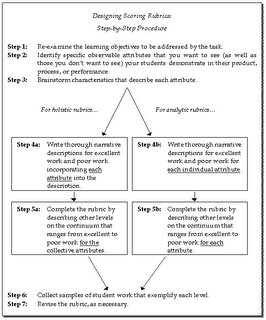Designing Scoring Rubrics for Your Classroom (Craig Mertler, BGSU)
Rubrics are rating scales-as opposed to checklists-that are used with performance assessments. They are formally defined as scoring guides, consisting of specific pre-established performance criteria, used in evaluating student work on performance assessments. Rubrics are typically the specific form of scoring instrument used when evaluating student performances or products resulting from a performance task.
There are two types of rubrics: holistic and analytic. A holistic rubric requires the teacher to score the overall process or product as a whole, without judging the component parts separately (Nitko, 2001). In contrast, with an analytic rubric, the teacher scores separate, individual parts of the product or performance first, then sums the individual scores to obtain a total score (Moskal, 2000; Nitko, 2001).

Authentic Assessment Toolbox (Jon Mueller)
Weighting certain skills or categories within the rubric should also be considered.
Create & Save Your Own Rubrics
RubiStar is a FREE online tool to help the teacher who wants to use rubrics but does not have the time to develop them from scratch. There are about 50 categorized templates to start with when creating a rubric for your own assignment. You select appropriate criteria from pull down menus and descriptions are instantly added into the four rated columns. Each criteria, rating/score and description is editable either online in Rubistar or after downloading it into an Excel file.
These rubrics can be printed, saved as web browser files or downloaded as Excel spreadsheets to be manipulated further, as needed. For example, if you'd like to add a column for "Student Self Evaluation", you could do that in the Excel version by simply adding a new column and typing in a new heading as needed.
No comments:
Post a Comment